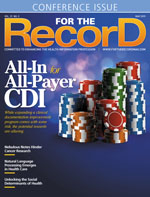May  2019
2019
Inside Interoperability: Four Ways Big Data Advances Telemedicine
By Vinati Kamani, MD
For The Record
Vol. 31 No. 5 P. 8
In the current health care environment, telemedicine is emerging as a popular option among providers. Oddly enough, there isn’t something radically new about the technology. In fact, the practice of telemedicine has been around since the mid-1960s.
So what exactly is propelling the recent expansion of telemedicine?
Its popularity can be attributed to a number of factors. Technological advancements that facilitate data transfer and ease of communication over larger distances, an increase in medical data generated by Internet of Medical Things (IoMT) devices, and improvements in data processing and analytics techniques all contribute to the widespread applicability that telemedicine is currently receiving.
Analytics Takes Shape
Big data analytics examines large sets of diverse data to uncover patterns, correlations, and trends in order to gain critical insights and make informed decisions.
The shift of medical records from conventional paper-based systems to electronic versions and their subsequent storage on the cloud has led to an increase in the production of medical data. In addition, health care apps and IoMT devices are producing huge quantities of patient data.
Processing these data through the use of analytics techniques and leveraging the power of artificial intelligence can lead to significant insights into how to improve care and limit expenses. Telemedicine is one area that has benefitted greatly from this development. In fact, it can be argued that analytics is revolutionizing the technology.
The previous evidence-based model of health care delivery, which focused primarily on curing ailments, is gradually being replaced by a holistic, outcome-based model that aims to understand and eliminate the causative factors behind medical conditions.
When it comes to telemedicine, this development is noticeable in several areas.
Remote Patient Monitoring
Telemedicine platforms allow patients who are restricted by geographical location, physical limitations, and financial constraints to conduct remote visits with health care providers. The use of smart health devices gives the medical practitioner access to vital patient statistics and health data.
Like much of the world around us, the health care field is becoming largely mobility driven. Using the data collected by numerous health care– and fitness-based mobile apps, health care practitioners can not only monitor patient health remotely but also prescribe effective treatment plans.
Remote patient monitoring ensures that health care services can be availed by patients from the comfort of their own homes. Through the use of analytics, real-time patient data can be collected and processed in order to compute the effective medication dosages and help clinicians develop treatment plans.
Predictive Analytics
Patient data are crucial for diagnosing patients via telemedicine where the clinician cannot rely on the traditional diagnostic methods that involve a physical exam. Use of these data helps not only in reaching the current diagnosis and creating a treatment strategy but also in predicting future outcomes.
Predictive analytics is instrumental in the identification of patients at high risk of developing certain health conditions. By monitoring the readings of devices such as heart rate sensors and pulse oximeters, clinicians can track measurements over time. The analytics algorithms can sift through historical data to identify high-risk patients and give them priority treatment.
Big data allows for the creation of risk scores based on the data collected. This information can be used to identify and track individuals who are found to be at elevated risks of developing chronic ailments. As a result, conditions can be caught at early stages of disease progression, leading to significantly improved patient outcomes.
Precision Medicine
On the basis of data analytics techniques, treatment plans can be personalized for those being cared for via telemedicine. This concept leads to a shift away from medicine’s one-size-fits-all approach to designing individual treatment plans.
The patient data collected from wearable devices, health care–based apps, medical records, and genomics can be tapped into for developing medication that caters to individual patients. Precision medicine takes into account variations in lifestyles, genetic makeup, and environmental conditions.
Predicting Infection Trends
Use of big data along with artificial intelligence algorithms is proving to be a valuable asset for predicting infection trends. Big data is crucial for updating the current disease spread models and designing newer models of disease progression. Data-driven insights into how infections spread through population cohorts and understanding the factors affecting their progression are important to eliminate the threat of infectious diseases.
Upon identification of the regions that would most likely be affected by the spread of infection, telemedicine services are deployed to remotely treat the affected individuals. This not only prevents the infection from spreading further but also enables medical professionals to cater to a large population in a more effective manner.
The Future
The confluence of telemedicine with big data analytics promotes a value-based model of health care delivery and reduces costs significantly. By utilizing data-driven insights into patient health via telemedicine, clinicians can provide a better level of care and produce better outcomes.
The massive amount of health care data currently being generated from various sources is beyond human computational abilities. Use of advanced analytics techniques reduces the amount of resources necessary while significantly reducing costs. Because it increases diagnostic accuracy and clinical efficiency while taming out-of-control costs, advanced analytics is beneficial to both patients and health care providers.
The influx of further technological advances—such as the use of artificial intelligence and cloud computing—will only help in advancing telemedicine and make health care more accessible and cost-effective for everyone.
— Vinati Kamani, MD, a medical doctor turned writer, writes about emerging health care technology and their applications across industries for Arkenea.



